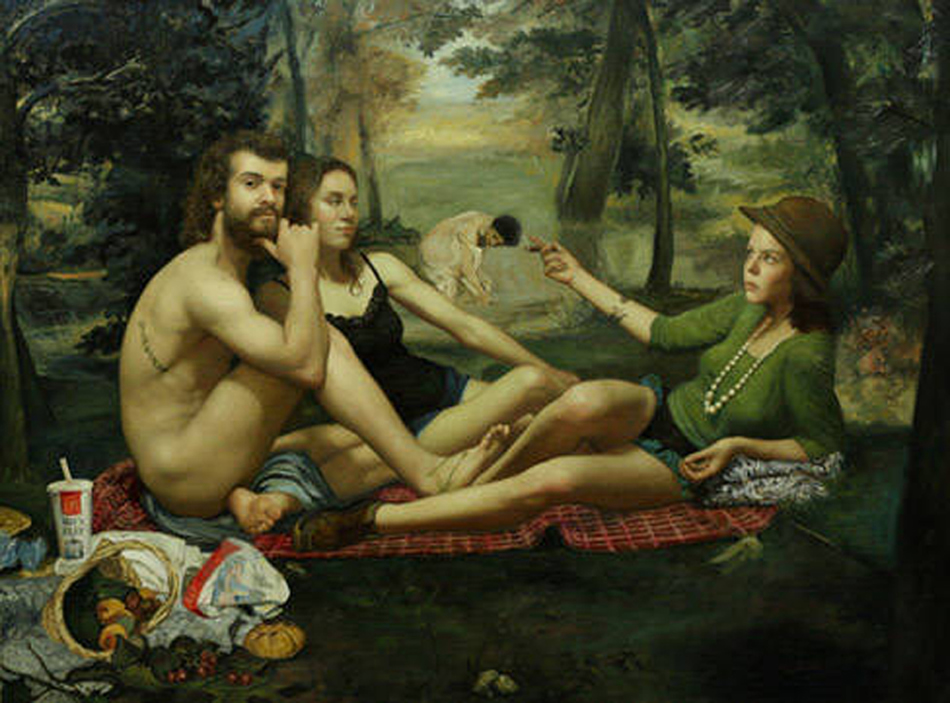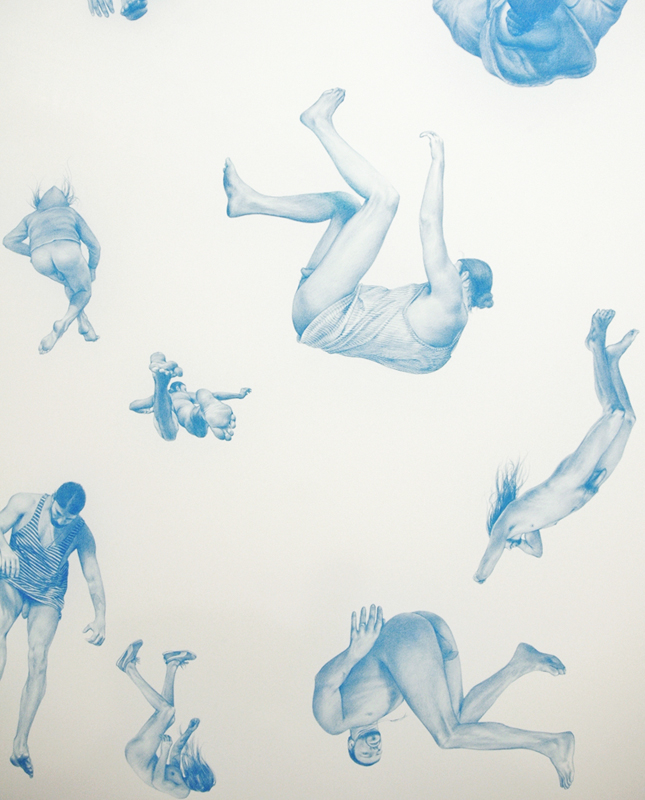Cesar Santos; Syncretism
Eleanor Ettinger Gallery
October, 2011
For the Artist, working with the visual pun can be a risky venture. In the masterful hands of Cesar Santos, the appropriation of iconographic images from art history goes far beyond the initial pun and makes for a feast of color and composition. Santos has adopted the concept of syncretism into his mature body of work and takes us on a tongue and cheek ride through art history.
Syncretism: the collision or reconciliation of disparate beliefs, systems of thought and forms of expression culminating in the harmony of eclectic sources. Its meaning is usually found in the amalgamation of religious practices, but for Cesar’s purposes, in his art. Mimicking the techniques of artists from across the centuries makes for an interesting juxtaposition of highly-trained classical skills against the relative freedom of techniques behind much modern painting.
Syncretism: the collision or reconciliation of disparate beliefs, systems of thought and forms of expression culminating in the harmony of eclectic sources. Its meaning is usually found in the amalgamation of religious practices, but for Cesar’s purposes, in his art. Mimicking the techniques of artists from across the centuries makes for an interesting juxtaposition of highly-trained classical skills against the relative freedom of techniques behind much modern painting.
There have been certain convictions on the part of some critics that the artist’s aim here has been to show the superiority of classical mastery when compared side by side on the same canvas with images by De Kooning, Mondrian and others. I think that is too simple and misses the point. Santos also references Rembrandt, Caravaggio and Manet with the same nod to humor and referencing contemporary societal trends as well. These painters are the prophets of classicism to any student of such, and occupy an almost divine level of respect from their accolades.
In a work such as “New Tatoo”, Santos appropriates Caravaggio’s “Doubting Thomas” in which a young woman’s Christ-like wound for a Hello Kitty tattoo on the girl. It’s a subjective approach asking which, whether religion or Kitty kitsch is more real or filled with personal relevance to an individual or a culture in modern times? The painting is rich with the masters striking chiaroscuro, and a bemused Rembrandt looks at us from his own self portrait inviting us into the joke.
Flipping Manet’s master work “The Luncheon on the Grass” is Santos’ version simply titled “Picnic in Central Park” in which Santos puts himself in the place of Manet’s nude courtesan, and replacing the two men with his wife and a friend. Santos further reminds us of our contemporary desires by placing a McDonald’s lunch and super sized drink along side the healthier foods equated with a picnic in Manet’s time.
In the compelling and beautiful “Aftermath”, Santos moves to his own compositional devices, juxtaposing Van Gogh’s “Starry Night” with a head from Picasso’s “Guernica”, leaving one to reconsider Vincent’s frenzied lush interpretation of a summer night. Under a sky filled with the roiling remnants of gunpowder and war, the central figure is being placed with reverence on a white marble slab, signifying the coldness of death and the purity of this subjects sacrifice.
Another critic has deemed this as the metaphorical death of pure classical ideal in its breakdown, starting with the impressionists to the further distortions of Picasso. Most working artists and critics appreciate Van Gogh’s groundbreaking brushwork and acknowledge Picasso’s early mastery of academic training, so again I don’t find much credence in the former interpretation. Santos was also a student of modernism for many years, so there is most definitely a deeper level to understanding these works and his appreciation of the movements of the 20th century. I am of the opinion that this breakdown was a necessary personally for him as an artist trying to determine his own place in history. ossibly the two most subversive works in the exhibit were “Woman with Glasses and Goatee” and “Drawing at the MOMA”. In the first we witness an almost classically draped woman, spray paint in hand, tagging one of De Kooning’s most iconic painting – with a gesture echoing Duchamps drawing of a mustache on the Mona Lisa. All of this foolishness masking the laborious recreation of an artwork, itself not so much painted, as violently hurled against a canvas. And while Santos’ approach to all of these techniques is the embodiment of serious art study, the end result is a “lightening up” of some serious art.
In “Drawing at the MOMA”, the composition is formed by the soft roundness of the nude woman against the backdrop of geometric shapes, which balance each other nicely. What dawns on the viewer is the initial shock of seeing art students sketching masterworks at The Metropolitan Museum of Art in New York City, I don’t recall ever seeing the same at MOMA. Honestly, no matter how much I love many of the artworks there, what would be the point of replicating them? Again, I think of Marcel Duchamp’s scandalous placing a urinal in an exhibit devoted to serious art. As the girl’s looping sketch suggests, it’s about the absurdity of an exercise in formality, in a place where almost none exists. I think Duchamp would have enjoyed the pun very much.

















